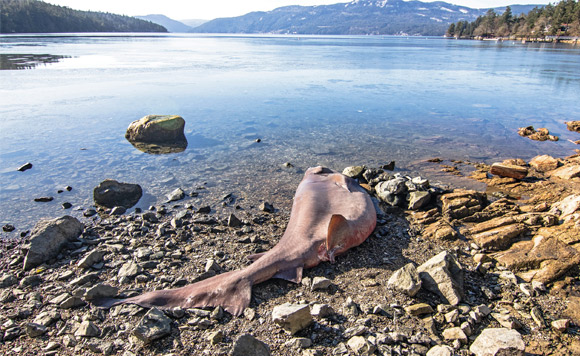by Tina Kelly, Shaw Centre for the Salish Sea –
“10-foot-long Shark Washes Ashore in North Saanich” – a shocking news headline for many. A bigger surprise may be – according to Canada’s Department of Fisheries and Oceans (DFO) – 14 species of shark have been documented inhabiting our West Coast waters.
To most, sharks are more commonly associated with warmer climes and the majority of the almost 500 known species of sharks* are found there. Of our 14 species, some are considered common and several have been documented but are rare, either due to low numbers or because they may only stray into our region during warm water events.
The shark ashore in Coles Bay – a bluntnose sixgill shark – is one of our common species but is also widely distributed in many temperate and tropical seas. Why sixgill? Most shark species have five gill slits. Another difference between this shark and many others is the presence of only one dorsal fin instead of two. Upon close inspection, the dead sixgill was gravid (pregnant). As fish, sharks are often assumed to be egg-layers and some do, but not all. The bluntnose sixgill is ovoviviparous: young feed off individual yolk sacs within the mother, hatch inside and are delivered live.
Bluntnose sixgill sharks prefer living in deep water near the ocean floor but they can also be found in shallow waters and even at the surface. A decade or so ago, diving with sixgill sharks was an activity drawing adventure seekers to a reef off Hornby Island. Sightings have since decreased and this species is currently listed as “Special Concern” under the Species at Risk Act.
Other local species include brown cat shark, Pacific sleeper shark, salmon shark and tope shark. Fishers may be familiar with another common local: the spiny dogfish. This relatively small shark, at five feet, is often incidentally caught when salmon sport fishing and, due to its name, is often not thought of as a shark.
The second largest – at a whopping 33 feet long – species of fish in the world, the basking shark, is considered a local species, but is exceptionally rare. These large sharks inhabit surface waters, often with their dorsal fins exposed. While once common there are now only a couple sightings per year and they find themselves on the endangered species list. The toothless, plankton-eating basking shark was abundant prior to the 1950s. At that time, gillnet fishers reported basking shark entanglements ruining their nets, resulting in loss of income, and a government-sanctioned cull began. The combination of net entanglements, the cull and a fishery for the shark’s liver oil undoubtedly contributed to their current day endangered status.
Rare shark species – though still listed as sharks of British Columbia by DFO — include short fin mako, sevengill, common thresher, Pacific angel and even great white shark.
Whether it was a surprise to you or not, sharks are just another component of our incredible West Coast marine biodiversity.
Pop in to the Shaw Centre for the Salish Sea and ask one of our educators for a Department of Fisheries and Oceans Sharks of B.C. poster. Or download one at www.dfo-mpo.gc.ca. The Shaw Centre for the Salish Sea is open daily from 10 a.m. to 4 p.m.
Photo courtesy RonDeVries.
* https://worldanimalfoundation.org/advocate/shark-attack-statistics/




